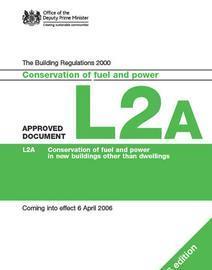While studying the new Part L documents, I noticed that the General Guidance Notes provide some important points.
For example, within Section 0 (types of work covered), there are statements about how fit-out works are to be handled. It states that reasonable provision in buildings falling under the aegis of ADL2A: 2006 "such as shell and core office buildings or business park units" - the latter presumably meaning those finished to developer's Category-A standard - would be to comply with the Target Energy Rating (TER) inferred by ADL2A Table 1.
It is broadly considered something of a challenge to meet this requirement and as the regulations tighten up in future, it is likely that more projects will be angled at achieving no more than compliance, especially in the realm of speculative commercial development.
For that particular subset of projects, whether designers are providing shell and core only or including Cat-A, the building services design would normally provide a general office environment. That design would form the basis of the systems input into the TER and Part L approval would be granted against it, assuming the Building Energy Rating (BER) is also acceptable.
It is often the case, however, that organisations will take a let on a newly-constructed building and introduce a significant amount of change so that the building meets their own business needs - ie they undertake a Category-B fit-out. The scope of that work varies widely, but can mean the introduction of new functional spaces such as kitchens, restaurants, gymnasia and the like - all of which often require additional central plant, and therefore additional CO2 emissions, to operate.
On one project I worked on recently, the Cat-B cooling requirements necessitated the addition of a fifth chiller of equal duty to the four base-build machines, representing a 25% uplift in capacity and an additional annual energy consumption for mechanical refrigeration of something like 10-15%, due to the nature of the connected load profile.
As it currently stands in the Part L approvals process, emissions from this chiller's (and its associated system elements) operation would not be recognised in a Part L assessment because in cases of post-construction Cat-B fit-out, the building will have already received its Part L approval. If the TER were to be on or close to the pass mark and the Cat-B fit-out sizeable, those emissions may have taken the CO2 total above the level required by ADL2A.
Not only does this condition have the potential to undermine the principles underlying ADL2A by effectively cloaking certain CO2 emissions generated as part of a building's normal use, but it could give rise to difficulties when such a building is due to receive an energy certificate in accordance with EPBD Article 7.
It is recognised that there are likely to be differences between the Asset Rating (AR) and Operational Rating (OR) because of probable misalignment between design intention and building use etc, but previously unrecognised Cat-B emissions will eventually appear through the certification analysis and exacerbate this difference, driving a wedge between the AR and OR. This could be difficult to explain if a significant amount of time were to pass after completion of the Cat-B fit-out before an energy certificate is required and the problem of potential Cat-B emissions were not generally understood and acknowledged.
Since ADL2A takes an interest in the post-construction period by insisting on building logbooks, it is arguable that it should include a mechanism for capturing any additional emissions brought about by Cat-B development. I therefore recommend that ODPM (now the DCLG) take a considered look at how this might be done as part of its next Part L review.
Keith Calder Eur.Ing
Source
Building Sustainable Design























No comments yet